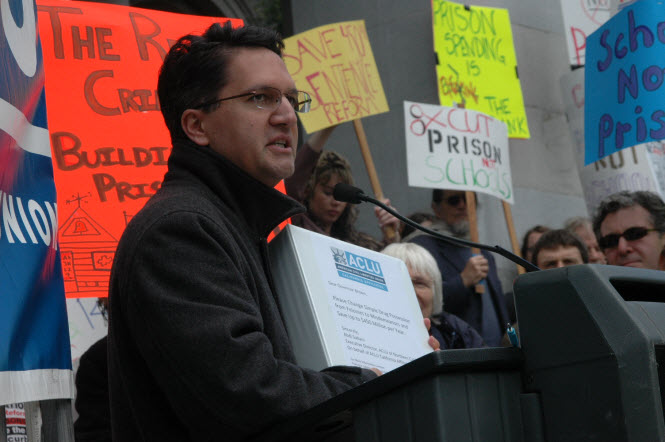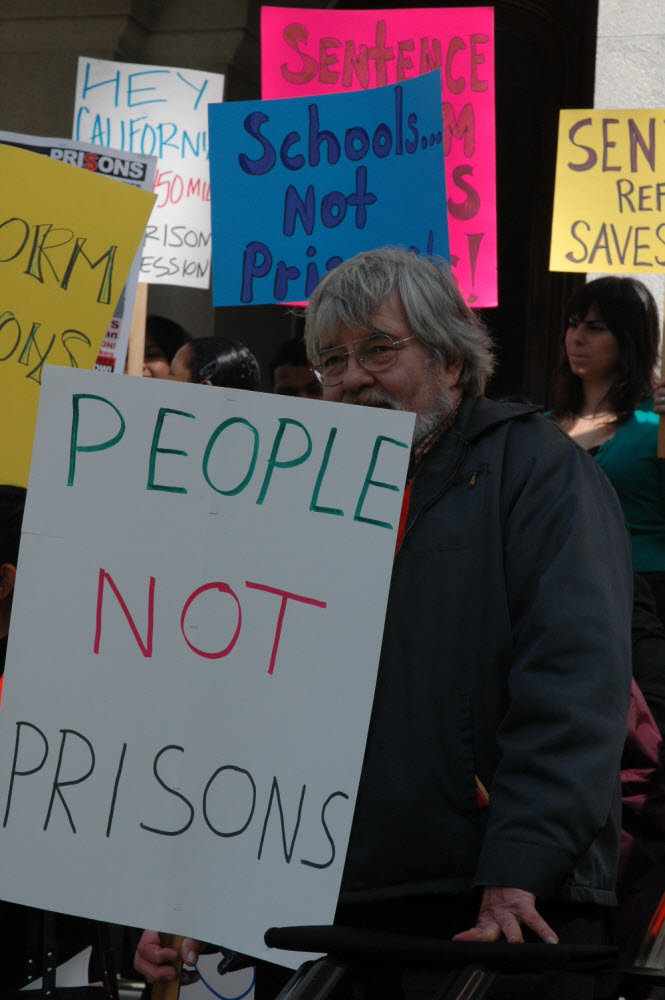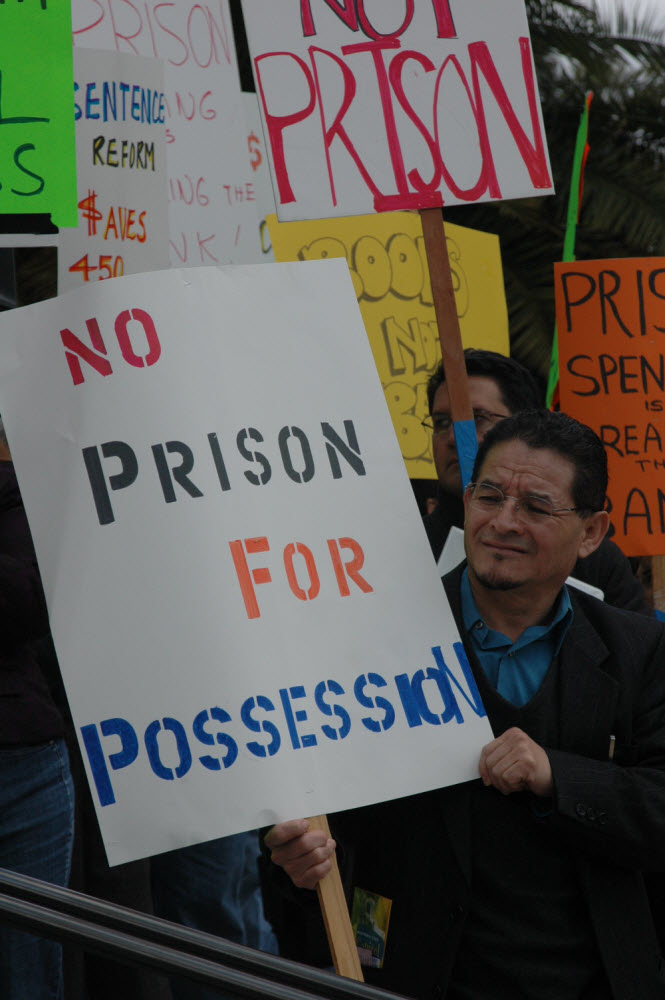
One simple reform would free up $450 million dollars, they say. According to them, that is the amount California taxpayers spend to lock up adults who were convicted of non-violent instances of possessing a small amount of drugs for personal use.
 lower cost — saving the state close to half a billion dollars.
lower cost — saving the state close to half a billion dollars.
“It’s time for California to stop spending hundreds of millions of dollars sending people to prison who pose no threat to public safety. Let’s invest in education, not incarceration,” said Allen Hopper, an attorney with the ACLU of Northern California.
They argue that during a time of declining crime rates, sentencing reform will help to preserve scarce dollars for education, health care and social services, and local police and firefighters.
Many states — New York, New Jersey, Michigan and Oklahoma among them — have recently made significant cuts to their prison systems by choosing not to incarcerate people convicted of low level drug offenses.
This is only the latest of such efforts. Earlier this year, Governor Jerry Brown proposed an end to prison terms for thousands of convicts who are in prison for relatively minor crimes. Those individuals would be moved to county jails.
Activists are correct to argue that these matters can be better and more cheaply handled at the local level. The problem is that county jails are at, near or even above capacity.
According to the Governor’s budget, such a move would save the state nearly half a million next year and $1.4 billion annually on an ongoing basis, while at the same time dealing with the critical prison overcrowding and prison reform issues.
The Governor’s plan is responsive to the building consensus among criminologists, justice advocates and finance experts who have been advocating a reduction of the prison population, believing that it could also produce enhanced public safety by moving relatively low-level inmates closer to their families and giving them access to better treatment programs.
The Governor argued in January that local government is in a better position to end “the revolving door of the corrections systems.”
“The agreement, approved by the Legislature last week with the passage of AB 109, the Criminal Justice Alignment Bill, illustrates that having counties take over functions of the state can present unexpected challenges. In this case, county officials balked at Gov. Brown’s plan to have counties handle the 1,200 or so youth now housed in five state youth correctional facilities,” reports Louis Freedberg from the California watch.
Reports Mr. Freedburg, “Costs to the state have risen to an astonishing $225,000 per offender. Early this year, Gov. Brown suggested that California become the first state in the nation to shut its youth correctional system completely and turn over the remaining wards to the custody of counties.”
Joan Petersilia, a Stanford University criminologist, told the Mercury News this week, “This is just an incredibly massive shift for a state system that was sending everybody and their brother to prison.”
But she offered widely-echoed caution: “We shouldn’t be naive and think we can do this on the cheap — these offenders have serious needs.”
“Our recidivism rate is high. Lockdowns are above the national average. The Supreme Court is breathing down our back,” the Governor said Monday. “It’s definitely an important area for reform and reduction.”
 The Governor added that legislators, district attorneys, sheriffs, police chiefs, probation officers and victims’ advocates all have agendas,
The Governor added that legislators, district attorneys, sheriffs, police chiefs, probation officers and victims’ advocates all have agendas,
Governor Brown said, “Each one can derail well-intentioned reform.” The issue is “full of competing claims and perspectives. Therefore, you have to do it surgically and with a great deal of sophistication.”
The Drug Policy Alliance has also endorsed the Governor’s proposal. They argue that it reverses a historic trend toward sending minor offenders to state prison that was “part of the tough on crime insanity that got us mass incarceration in the U.S.,” said Margaret Dooley-Sammuli, deputy state director of the Drug Policy Alliance.
“Nobody benefits by sending a shoplifter to state prison,” Ms. Dooley-Sammuli added.
About 10,000 people are in California state prison for drug possession and this proposal shift affects people incarcerated for the simple possession of drugs, among other petty offenses.”They’re not people convicted of possession less than an ounce of pot, which is an infraction,” the DPA stated.
“He’s not talking about potheads,” said Ms. Dooley-Sammuli. “But they do include some of the 17,000 or so arrested for sale or growing recreational pot in California, which can get up to four years in prison.”
“An uncounted number of parole violators are going back in for smoking a joint, she said, though the state doesn’t keep statistics on it. California’s recidivism ranks among the highest in the nation at about 71 percent. Roughly 10,000 people enter and exit state prison each month, and most are serving time for parole violations,” the DPA said.
However, not everyone is celebrating the much-needed reform to the prison system.
The Woodland Daily Democrat reports that Yolo County Sheriff Ed Prieto is concerned that if adult convicts are released to Yolo County, Monroe Detention Center would be packed well beyond capacity.
“We don’t have the facility to handle it,” Prieto told the Daily Democrat.
The paper reports, “The county jail, which holds 450 inmates, could be asked to hold up to 800 inmates. He said the jail is at capacity all the time. Unless Yolo County were to get a new facility, which Prieto said is unlikely, it’s not going to work.”
The death penalty is another way that reformers have attempted to link criminal justice reforms to the budget.
Argued the ACLU in January, “At least one overfunded, broken government program was allowed to keep its bloated budget without a single cut: the state’s billion-dollar death penalty.”
They break down the additional costs of the death penalty as follows:
It costs roughly $1 million per death penalty trial over and above the cost of non-death penalty murder trials. This money comes from county prosecutors’ budgets. For instance, if the DA took a plea agreement in the Topete case instead of trying for the death penalty, the county’s office may have additional money to fight other crimes.
In addition, the state spends “$63 million per year extra spent housing people on death row and another $60 million spent on their appeals, again over and above the cost of housing and appeals for life without parole.”
Moreover, these line items are hidden, “tucked away in the budgets for corrections, the Supreme Court, the attorney general’s office and public defense.”
Finally, the state is proposing building a new death row facility for $400 million when it has executed 13 people in the last 30 years.
Argues the ACLU, “Over five years, that tally comes to just over $1 billion.”
“Now, repealing the death penalty in California can only be done at the ballot box,” they argue, “but defunding the whole system can be done with a few strokes of the governor’s pen: just ask any senior citizen, recipient of in-home medical care, or single working parent. They’ll tell you how powerful that pen can be when it comes to cutting government programs.”
The numbers are staggering in a time of budget cuts and billions cut to education.
For 2009, they found that, “California taxpayers spend an estimated $117 million each year at the post-conviction level seeking the execution of the 680 inmates on death row.”
A fraction of the billions cut to education, but how many teachers would $117 million pay for?
Moreover, “Death penalty trials cost local taxpayers an additional $20 million per year, at the current death sentencing rate of 20 sentences per year.”
They continue, “In total, the death penalty system cost California taxpayers $137 million each year, the California Commission on the Fair Administration of Justice found, whereas permanent imprisonment for all those currently on death row would cost just $11 million.”
Finally, the death penalty does not work. It is not currently being implemented in California. There are nationwide problems that have led to states like Illinois, New Mexico, and others banning the death penalty.
There are problems of unequal application, and problems of the execution or potential execution of innocent people because the system is so bad. We could save millions by converting these sentences to life without parole.
We simply need to end prison sentencing and clogging court rooms with simple possession cases. We have covered trials utilizing court resources, prosecutors and public defenders for small quantity drug possession. Some of these cases are being prosecuted for less than one tenth of a gram of meth.
Meth is one of the worst drugs that we have out there, but if we move resources from the criminal justice system toward health and other support resources, we would save millions.
It is far cheaper, even, to put people in residential treatment programs rather than send them to prison. With the money freed up, we could invest in programs like education, job retraining and mental health services. We could actually have a chance to break the cycle and attack crime not after it has happened, but at its source.
In order to do that, we have to get over our fears that changing drug laws will bring forth deep dark forces. We can no longer continue, at a whole host of levels, to practice law enforcement as we have. We simply do not have the resources.
—David M. Greenwald reporting

Excellent post David. I have no background or expertise to substantiate your financial numbers, but what is clear is that it makes no financial sense to spend millions on a process that we do not even implement , the death penalty. And this statement is true whether one is a supporter or opponent of the death penalty.
If any governor would have the ability to make progress on this issue it would be Gov. Brown since I believe him when he says he has no aspiration to higher office. I hope he will take this on, single handedly if necessary.
Before I can buy off on this idea I’d like to see the definition of a “minor drug offense”.
dmg: “Governor Brown said, “Each one can derail well-intentioned reform.” The issue is “full of competing claims and perspectives. Therefore, you have to do it surgically and with a great deal of sophistication.””
To balance the state’s budget, sloughing off state responsibilities onto cash strapped counties is implementing reform “surgically”? Give me a break!
So where is Gov Brown’s courage in defunding the death penalty to save money, rather than passing the buck to counties?
dmg: “An uncounted number of parole violators are going back in for smoking a joint, she said, though the state doesn’t keep statistics on it.”
So in other words, there is no data on whether this is a problem or not…
Possession for personal use, no accompanying felony crimes.
Elaine: if I understand the proposal here, the idea would be that since counties can handled it cheaper and better, the state cover the costs to the counties and pocket the savings.
[quote]Possession for personal use, no accompanying felony crimes.[/quote]
Possession of marijuana or possession of anything?
Possession of any drug.
dmg: “Elaine: if I understand the proposal here, the idea would be that since counties can handled it cheaper and better, the state cover the costs to the counties and pocket the savings.”
I guarantee the state will not cover all the costs to the county – to put it bluntly “aint gonna’ happen”!
[quote]Possession of any drug.[/quote]
I would have agreed with marijuana but not meth or cocaine ect. There is to much information out there linking the hard drugs to serious crimes. If you take the prison aspect away from hard drug cases you are essentially legalizing it. I like how it’s said the local agencies are better equipped to deal with the problem. Yes, our county drug programs are so successful.
Prohibition did not work well for alcohol . Why would we think it would work well for drugs ?
Another example of our societal hypocrisy. Alcohol is ok despite the number of addicts. Prescription opiates ? Also socially sanctioned.
Cigarettes ? Absolutely legal although probably amongst the most addictive and destructive of drugs.
I would argue in favor of incentives to not start drugs, effective treatment programs for those who are already addicted, and an end to jail and or prison sentences for nonviolent offenders given the ineffective and costly nature of imprisonment.
Elaine: Then you end up with a situation that the counties start releasing their low level offenders, which is where I think they should go anyway, but I’d rather replace that with programs rather than nothing.
Mr. Obvious: Our county drug programs are not successful – but part of the problem is that they are underfunded and not nearly long enough. You don’t change addiction in a six month residential or one year out patient program. You also don’t do it without education and job training mixed in. If we shifted the $50K in incarceration to those kinds of programs, they might be more successful.
In terms of linking of meth or cocaine to other crimes, well incarcerate them for other crimes when they commit other crimes, don’t just presuppose they will. Most of the other crimes are linked to the fact that these drugs are illegal and trying to obtain them illegally.
Elaine: Then you end up with a situation that the counties start releasing their low level offenders, which is where I think they should go anyway, but I’d rather replace that with programs rather than nothing.
Mr. Obvious: Our county drug programs are not successful – but part of the problem is that they are underfunded and not nearly long enough. You don’t change addiction in a six month residential or one year out patient program. You also don’t do it without education and job training mixed in. If we shifted the $50K in incarceration to those kinds of programs, they might be more successful.
In terms of linking of meth or cocaine to other crimes, well incarcerate them for other crimes when they commit other crimes, don’t just presuppose they will. Most of the other crimes are linked to the fact that these drugs are illegal and trying to obtain them illegally.